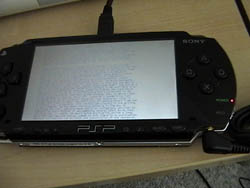 Not surprisingly, folks have already figured out how to read books on the new Sony PSP (PlayStation Portable). The hack is pretty basic – you just turn pages into jpeg images and dump them into the picture folder. The snapshots stack up as a book. Packet Switched Press has even published a short story – a sci-fi piece called “Moving Pictures” – formatted specially for the device (you’re supposed to rotate it 90 degrees to view vertically) (thanks, Boing Boing).
Not surprisingly, folks have already figured out how to read books on the new Sony PSP (PlayStation Portable). The hack is pretty basic – you just turn pages into jpeg images and dump them into the picture folder. The snapshots stack up as a book. Packet Switched Press has even published a short story – a sci-fi piece called “Moving Pictures” – formatted specially for the device (you’re supposed to rotate it 90 degrees to view vertically) (thanks, Boing Boing).
The PSP marks another step toward an ideal portable media device (see the ideal pod), the ebook hack being only one of many tricks to cram in more content options (Wired article for more). The Packet Switch Press story suggests that on the tiny screen, 90 degrees can be all that separates a widescreen movie from an electronic paperback – there’s no “this side up.” The big problem with the PSP is its proprietary file format, laughably named Universal Media Disc (UMD). To watch a movie on your PSP, you have to buy the UMD-formatted edition, even if you already own the DVD. This will ultimately inhibit the development of interesting new works for the tiny screen, clever hacks notwithstanding.
if:book
A Project of the Institute for the Future of the Book

The PSP also has the ability to play recorded video off of its Memory Stick flash storage card.
Furthermore, it has the ability to playback that video at a frame by frame advance rate. Giving one the ability to store the “pages” of a book on individual video frames and advance through them at will.
At 30 frames per second, one minute of video would hold 1800 pages. Each page/frame would probably take about 1Kb. That means that a 1Gb card (the largest currently available) could hold one million pages.
Of course, this would still represent/maintain a very linear approach to the concept of a “book.”
Agreed. Without a navigation system that’s more complicated than flipping through a stack of cards, you’re not going to get much more than a simulation of a paper book, and a pretty poor one at that. With the exception of the screen (in spite of its high resolution, LCD is fundamentally hostile to the eye), the hardware is more than ample to handle sophisticated multi-directional reading. It’s the software that’s lagging. Software in the sense of a reader format, but also the books themselves – content that will demand to be read on a screen.